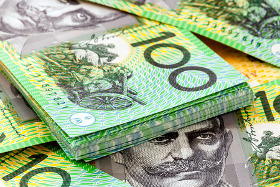The Australian dollar was among the strongest most-traded currencies today thanks to the risk appetite caused by the surge of the Nikkei stock index. Decent macroeconomic data in China, Australia’s biggest trading partner, and in Australia itself also provided support to the Aussie.
The Reserve Bank of Australia reported that private sector credit fell by 0.1% in July, decelerating from the previous month’s 0.2% rate of decline and matching expectations. According to a report from the Australian Bureau of Statistics, the seasonally adjusted estimate for company gross operating profits climbed by 15.0% in the June quarter versus market expectations of a 6.0% drop. The Melbourne Institute Inflation Gauge was at 0.1% in August, slowing from 0.9% in July.
China’s official manufacturing Purchasing Managers’ Index was at 51.0 in August, near the market consensus and the previous month’s figure of 51.1. Being above the neutral 50.0 level, the index shows that the sector is expanding. It was the sixth straight month of increase, suggesting a robust recovery of the manufacturing sector from the crash caused by the coronavirus pandemic. The non-manufacturing PMI demonstrated an increase to 55.2 from 54.2, reaching the highest level since January 2018. That suggests that the services sector fairs even better, and the Chinese economy looks relatively healthy overall.
Now, traders wait for the RBA monetary policy decision. The central bank will announce its decision at 4:30 GMT on Tuesday.
AUD/USD gained from 0.7359 to 0.7388 as of 18:01 GMT today, trading near the highest level since August 2018. EUR/AUD fell a little to 1.6161 from the open of 1.6169, retreating from the session high of 1.6223. AUD/JPY advanced from 77.52 to 78.22.
If you have any questions, comments, or opinions regarding the Australian Dollar, feel free to post them using the commentary form below.
Australian Dollar Among Strongest on Economic Data, Risk Appetite
